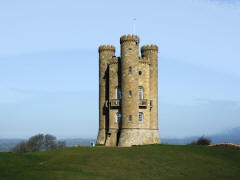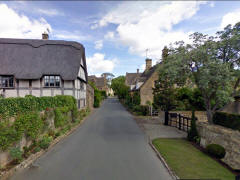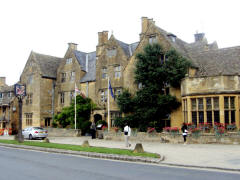|
Page 1 2 3 4 5 6 7 8 9 10 11 12 13 14 15 16 ENGLAND: LONDON
AND THE COTSWOLDS STRATFORD-UPON-AVON
Tuesday, May
17. We had a nice breakfast at the
hotel, and Lee picked us up
promptly at 9:00 as planned. Today
we were headed for
Stratford-upon-Avon, just outside
the northern edge of the Cotswolds.
We had taken a bus tour there in
1980 when we visited the UK for a
few days following a business trip
to the Continent.
Lee got us to Stratford about 9:30 and he was able to park fairly close to Shakespeare's house, our first stop in Stratford. William Shakespeare (1564-1616) was born and lived his childhood years in this house. After later inheriting it from his father, he owned it for the rest of his life but did not live there. (He lived in London.) The house was restored beginning in the mid 19th century. The tour of the house tries to create a picture of family life during Shakespeare 's time. After the tour we went into the backyard where docents explained things about the house and garden and also performed excerpts from Shakespeare’ works. We were at the house for almost two hours.
Then we met Lee and
he drove us to Ann Hathaway's
cottage. We had also visited it in
1980, but nothing looked familiar.
Anne (1556-1623) was Shakespeare's
wife, and this is the house where
she lived at least until their
marriage in 1582. She may have
lived there after that as well
since Shakespeare spent most of
his adult life in London while
Anne remained in the Stratford
area. The house is very large to
be called a cottage. As can be
seen from both the outside and
inside, it was built in three
major sections, beginning before
1500.
Much has been written about the relationship between Anne and William, but most of it is wild speculation based on the few known facts: Anne was 26, William 18, when they married, and she was pregnant. They seldom lived together, but they still had three children. The only mention of Anne in his will was to leave her "the second best bed." We left the cottage, and Lee drove us to the Mary Arden Farm in the village of Wilmcote, just a few minutes away. This farm was once owned by Shakespeare's mother, Mary (although the house originally thought to be hers turned out to be that of a neighbor, Alan Palmer). It was after 12:30 when we arrived, but we decided to wait to get something to eat even though there was a snack bar near the entrance. We stopped to watch the lady blacksmith, then continued past several other exhibits. After going through the Great Barn, we spotted the large farmhouse (Alan Palmer's, not Mary Arden's) and walked in that direction. We passed a mill and came to the fenced barnyard where various fowl were penned.
As we came upon a docent, an older woman,
carrying reeds, she identified
herself as a basket maker. She
was so eager to tell us about
the farm that we could not get
away from her to go see the
house. We finally got away and
went inside. We made a quick
tour through the house.
We eventually came to the kitchen
where the
docents were
engaged in readying the days main
meal. We went to the dining room
to watch, but the scene was slow
to unfold. As more and more
spectators gathered around us, the
food was prepared, the table set,
the participants seated, but they
kept saying they had to wait for
"the master." Eventually he came
and sat down at the table. Grace
was said, the food was passed
around, and they began eating,
engaged in lively conversation
about the farm the whole while. We
had been in the house less than 25
minutes, but it seemed much
longer, perhaps because we were
hungry ourselves. At about 13:15
we started edging toward the back
of the crowd and eventually
slipped out as the meal continued.We headed back to the snack bar, hoping to have an "afternoon tea." We had learned by this time that the afternoon tea was the "big" tea, larger than a cream tea. Jane was hungry and insisted that we order two, rather than share one. It turned out the this place had the most generous tea we have seen of any kind. We got two very large pots of tea, two full sandwiches (four halves), two very large scones with clotted cream, two smaller rolls, and two very large pieces of cake. It was difficult to finish it all - but we did. One would have been more than sufficient for the two of us. It was after 14:00 when we went back out to finish our tour of the farm. After seeing several more types of farm animals, we noticed that the falconer (who turned out to be "the master") was about to begin a demonstration. He had a string around the falcon's leg so it could not fly away. Not to worry. No matter how much he coaxed the falcon, it would not leave the bench where it was perched. After 15 minutes we finally gave up and started toward the farm's exit. We ran into a shepherd with a large sheep. After spending about ten minutes with the shepherd, we looked back and the falcon still had not moved.
We were supposed to meet Lee at 15:00 and he was there waiting. We drove south for about half an hour to the Broadway Tower, an isolated castle-like tower said to have been built (1799) as a "folly." From there we made a loop through the small villages of Snowshill, Stanway and Stanton, sometimes taking narrow farm lanes to get from one to another. In Snowshill, a very compact village, we walked completely around the grounds of St. Barnabas Church (1864). A funeral was in progress and we had a short talk with the young gravedigger. In Stanway we saw only a few scattered houses. Although there was a large manor house (Stanway House), we did not see it. Stanton was a typical Cotswold village, stretching out along a wide "S" curve. Our last stop, about 16:15, was Broadway, a large village sometimes called the "Jewel of the Cotswolds." The weather had been changeable all day and at this point a sporadic light rain began to fall. After a brief spin around the village, Lee dropped us off on the east end of High Street, lined with red chestnut trees and an almost unbroken line of limestone buildings, many dating from the 16th century. We walked as far as the Lygon Arms (pre-1532) and turned back for our 17:00 pick up. Chipping Campden was only a few miles from Broadway , and we were in our hotel by 15:15. We decided not to do any more exploring that evening. The weather was threatening and we were tired. We ate in the hotel bar again. By this time we had discovered that there was a small dining room behind the bar area and we sat there.
|



